Stellantis became the second Big-Three manufacturer to reach a tentative deal with the United Auto Workers union over the weekend, ending more than 40 days of strikes at the Jeep-Chrysler maker’s U.S. facilities.
The Stellantis agreement arrived on Saturday, three days after Ford successfully negotiated its own contract with union leaders last Wednesday. Although the exact terms of either deal have yet to be published, both contain similar compromises. According to United Auto Workers leaders, employees at the two companies will receive a 25% pay raise, along with cost-of-living adjustments, improved benefits and accelerated paths to permanent positions for temporary workers. Stellantis has also agreed to reopen its Illinois Jeep Cherokee plant, which had been idled earlier this year against the union’s wishes.
United Auto Workers members must still vote to ratify the deals, although union leaders have yet to announce a timeline for voting to take place. Should employees reject either proposal, UAW leaders would be forced back to the bargaining table with Detroit-Three executives, causing strikes to resume. However, union leaders have already called on Stellantis and Ford workers to return to their jobs, partly to show goodwill toward the two automakers and partly to incentivize the slow-moving General Motors, who reached its own tentative deal earlier today.
While the final cost of the strike is unclear, the financial losses sustained by Detroit-Three automakers over the last six weeks are likely in the billions. Leading up to the agreements, OEM executives frequently claimed that the union’s demands were untenable and would place the industry’s future in jeopardy. Although United Auto Workers leaders have challenged these narratives, they have also drastically cut back on their initial goals, which originally included a 46% pay raise.





